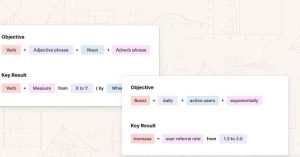How Do You Write OKRs Effectively?
Grasping the Basics of OKRs
Objectives and Key Results (OKRs) are strategic tools used by organizations worldwide to set ambitious goals and track progress toward them. They consist of an Objective, which is a clear, actionable goal, and Key Results, which are measurable steps to achieve the Objective. This framework helps teams to focus on driving exceptional outcomes.

Setting Powerful Objectives
A powerful Objective should act as a beacon for your team, inspiring action and providing clear direction. It should be ambitious enough to push your team but realistic enough that it doesn't seem unattainable. For instance, a software company might set an Objective to "Capture the largest market share in the mobile gaming industry by the end of the year." This is direct, inspiring, and stretches the team to reach new heights.
Defining Precise Key Results
Key Results should be specific metrics that measure progress towards the Objective. They need to be quantifiable and deadline-driven to provide a clear path to success. For example, Key Results for the above Objective could include "Increase user base by 50% by Q3" and "Launch three new strategic partnerships by Q2." These are measurable, time-bound, and directly contribute to achieving the overall Objective.
Alignment Across the Organization
Alignment is critical when you write OKRs. Each team's OKRs should ladder up to the broader company goals, ensuring that every effort contributes to the bigger picture. Advanced OKR software often shows how individual OKRs tie into departmental and company-wide goals, improving transparency and alignment. Statistics show that organizations with high alignment have 70% better performance compared to those with poor alignment.
Cultivating Engagement Through Accountability
Engagement skyrockets when team members know their work has a direct impact on the company’s success. Making OKRs visible to all and holding regular check-ins can foster a sense of ownership and accountability. Successful companies often use dashboards where everyone can see real-time progress on OKRs, boosting motivation as team members see how their efforts contribute to achieving common goals.
Iterating and Adapting
OKRs are not set in stone; they should be flexible and evolve as circumstances change. It’s important to review and refine OKRs regularly—at least quarterly. Adjustments may be necessary to reflect new challenges or opportunities that arise. This iterative process ensures that your OKRs always remain relevant and aligned with your company’s current state and ambitions.
Driving Success with Well-Written OKRs
Effective OKRs can radically transform how a company operates and achieves success. They clarify what needs to be accomplished and mobilize teams to achieve more than they thought possible. The clarity provided by well-crafted OKRs can lead to a 50% faster achievement of goals as teams are not bogged down by uncertainty or misdirection.
Moving Forward with Clarity and Precision
To write OKRs effectively, focus on clarity, alignment, and the measurable impact of each Key Result. This approach not only propels your team forward but also embeds a culture of continuous improvement and high performance. As your organization grows and evolves, so should your OKRs, adapting to new goals and market conditions to keep your team on the path to exceptional achievement.
